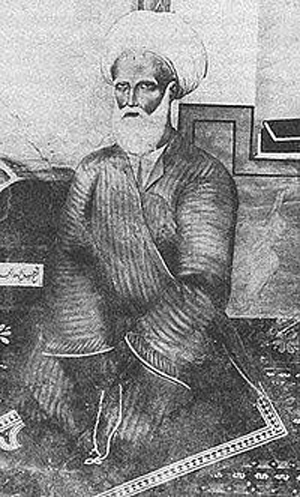The views expressed in our content reflect individual perspectives and do not represent the authoritative views of the Baha'i Faith.
With the rise and havoc caused by groups like ISIS, Al-Qaeda and the Taliban, you’ve probably heard the term Wahhabi.
For those who haven’t heard it, Wahhabi is the literal Islamic theology which underlies the foundation of the Kingdom of Saudi Arabia.
This theology was founded by Muhammad ibn Abd al-Wahhab in the mid 1700’s. What is not commonly known is that a stark, striking counterpoint to this ideology exists, born only 50 years later, also in present day Saudi Arabia. That counterpoint—in some ways the exact opposite of Wahhabism—was founded by Shaykh Ahmad. Shaykh Ahmad took Islam down a profoundly different road from Wahhabi theology and paved the way for the birth of a new, peaceful, progressive form of religion known as the Baha’i Faith.

Shaykh Ahmad
Muhammad ibn Abd al-Wahhab and Shaykh Ahmad were born about 370 kilometers apart near Riyadh and Al Hoff respectively, in present day Saudi Arabia. Muhammad ibn Abd al-Wahhab was born in 1703 and Shaykh Ahmad was born 50 years later in 1753. Both founded powerful new movements to reform Islam, but their ultimate trajectories and the fruits of their philosophy couldn’t be more different.
Muhammad ibn Abd al-Wahhab saw it as his mission to restore a more literal, purer and original form of the faith of Islam. Thus, those who espouse his theology refer to themselves as Salafists after the as-salaf as-saliheen (the earliest converts to Islam) or Muwahhidun, meaning, “the monotheists.” Towards this aim he proposed a more radical version of monotheism, which condemned and waged war against the veneration for any thing or person outside of the singular God. Thus the tombs of saints or the progeny of the prophet Muhammad were targets to be destroyed. Anyone who didn’t adhere to this interpretation were considered polytheists worthy of death, including fellow Muslims (especially Shi’ites, who venerate the family of Muhammad), Christians and others.
Some of al-Wahhab’s first actions on attaining authority with the ruler of the town of al-Uyayna was to destroy a sacred tomb revered by locals. He also ordered that an adulteress be stoned to death, thus reintroducing a brutal practice which had fallen out of favor. These actions created enemies, and he eventually had to flee al-Uyayna. However, he ultimately found strong patronage with Muhammed Ibn Saud, a chief of desert raiders in Najd. Together they formed a pact which placed the chief as head of all political matters. Muhammad ibn Abd al-Wahhab, as head of theological matters, declared the rulers of Hijaz (the holy Land of Arabia) to be non-Muslims due to their more tolerant practice of Islam—and therefore worthy of attack and occupation. Thus the fundamentalist dynasty of the house of Saud eventually conquered most of the Arabian peninsula, and with the discovery of oil and the influx of wealth, attempted to project the Wahhabi ideology around the world.
Shaykh Ahmad, on the other hand, belonged to the Shi’ite sect of Islam, and as such venerated and adhered to the teachings handed down by the Shi’ite Imams. Shaykh Ahmad believed in the eminent fulfillment of the prophecies in the Qur’an. He also taught a non-literal, symbolic interpretation of those prophecies, preparing the world for the coming of the Al-Qa’im or Al-Mahdi—the “guided one” and promised redeemer of Islam—and the return of Christ. Ultimately, Shaykh Ahmad also achieved much influence in present day Iran and the patronage of the ruling Persian Qajar dynasty.
He taught that the day of judgement should be understood in a non-physical manner, and that the rising of the dead was only meant in terms of their spirit. He appointed another mystic, Sayyid Kazim Rashti, to succeed him and carry his teachings forward after Shaykh Ahmad’s passing in 1826.
Sayyid Kazim clarified many of Shaykh Ahmad’s ideas. He also heightened Shaykh Ahmad’s expectations of fulfillment, devoting much time to describing the attributes of the coming promised one, delineating such details as his lineage, age and comportment. Sayyid Kazim did not leave a successor, but before his death in December, 1843, he counseled his followers to leave their homes to seek the Mahdi—who, according to his prophecies, would soon appear. Interestingly, this expectation also corresponded with predictions of Christian millennialist movements which were sweeping across America and western Europe at the same time and anticipating the return of Christ.
Then, on May 22, 1844, a relatively unknown young merchant named Sayyid Ali Muhammad assumed the title of the Bab (which means “Gate”) and claimed to be the promised one Shaykh Ahmad and Sayyid Kazim had foretold. The Bab’s first disciple, Mulla Husayn, was one of the chief followers of Sayyid Kazim, who on the death of his leader, set out to search for the promised one. This declaration attracted a number of the more illustrious followers of the Shaykhi school, Including the famous poetess and female disciple Fatima Baraghani, named “Solace of the Eyes”(Qurat-ul-Ayn) by Sayyid Kazim.
The Bab taught that he had come to prepare the way for another, greater messenger of God who would usher in the establishment of the kingdom of God on Earth:
The purpose underlying this Revelation, as well as those that preceded it, has, in like manner, been to announce the advent of the Faith of Him Whom God will make manifest …. The process of the rise and setting of the Sun of Truth will thus indefinitely continue—a process that hath had no beginning and will have no end. – The Bab, Selections from the Writings of the Bab, p. 105.
The Bab’s piety, loving nature, intoxicating presence, and ability to reveal Arabic writings of profound beauty and depth without premeditation won over many followers, despite the fact that he was not from the educated clerical class. The Babi movement spread like wildfire throughout Persian society, attracting tens of thousands of converts from all classes.
However, opposition from the ecclesiastical and governmental authorities hardened, especially after a famous incident in the Iranian town of Badasht. The early followers of the Bab had gathered together there to decide how they could liberate their imprisoned leader, the Bab. During a sermon Qurat-ul-Ayn gave there, she threw off her veil—causing shock and terror among the assembled men present—and announced “I am the Word which the Qa’im is to utter, the Word which shall put to flight the chiefs and nobles of the earth!”
For the Babis, this act signalized the termination of old Islamic sharia law, and the birth of a new divine law, which demanded equality for women, justice for all people, an end to warfare and the unification of humanity. Interestingly, this coincided with a signal event taking place on the other side of the planet, the first conference to address the emancipation of women in Seneca Falls, New York.
At the conference of Badasht, Qurat-ul-Ayn was given a new name: Tahirh (The pure one) by another prominent Babi and nobleman, Mirza Ḥusayn-Ali—who would later become known as Baha’u’llah (the Glory of God). In 1863, Baha’u’llah announced that he was the one foretold by the Bab, and the Baha’i Faith began.
















Comments
Sign in or create an account
Continue with Googleor